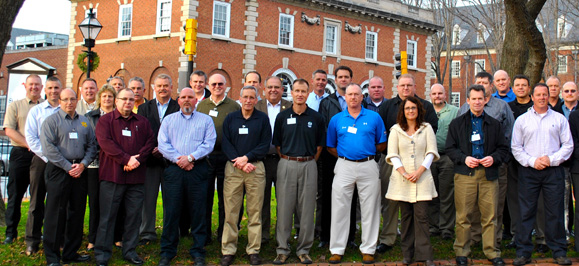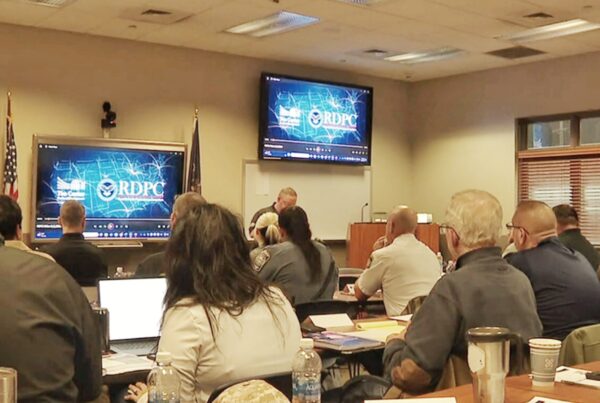A Kentucky program that provides technology assistance for small and rural law enforcement agencies across the nation helped Christmas come early for a rural Louisiana police department.
Police Chief Kevin Billiot of Montgomery, La., was one of 31 participants in the Fall 2011 Rural Law Enforcement Technology Institute, a national conference hosted Dec. 4-8 in Annapolis, Md. by the Small, Rural, Tribal and Border Regional Center (SRTB-RC). SRTB-RC is a Public Safety program operated by The Center for Rural Development in Somerset, Ky.
In these times of tightening budgets and limited resources, Billiot’s department needed almost everything it takes to equip and operate a police department: patrol vehicles, in-car video equipment, laptop computers, and even the most basic item for the winter season—heavy-duty coats for his officers.
“We have a group of dedicated officers and some of the most basic equipment, but beyond that we have little else,” said Billiot, who took over as the town’s police chief in April 2011. “The opening of Interstate 49 drew traffic, commerce and people away from our community. As a result, our tax base is virtually non-existent and we have very few resources.”
Billiot came away from the weeklong national event—which featured chiefs, sheriffs and command officers from 23 states—with more solutions than he could have ever imagined.

- Thirty one participants from small and rural law-enforcement agencies in 23 states attended the Fall 2011 Rural Law Enforcement Technology Institute, held Dec. 4-8 in Annapolis, Md.
Thanks to the Institute and fellow attending law-enforcement officials willing to lend a helping hand, nearly all of Billiot’s critical needs are in the process of being met without him having to spend or find any additional funds.
“One of the great things about the law-enforcement community is we tend to be very creative,” said Dave Mather, executive director of the National Law Enforcement and Corrections Technology Center’s (NLECTC) Small, Rural, Tribal and Border Regional Center (SRTB-RC), which hosted the Institute.
“We find creative ways of making do with whatever resources we have available. That creativity is great, because these creative solutions become solutions for all law enforcement,” Mather added.
The event’s primary goal is to serve as a national forum for law enforcement representing small and rural departments to come together and share technology tips that have brought about work-tested solutions.
Hosted each spring and fall by SRTB-RC, the Institute brings chiefs, sheriffs, and command officers together and gives each a platform to share a presentation on low-cost, highly effective technology and planning solutions for common small-agency issues.
Participants also have ample opportunity to discuss and network with one another on those issues throughout the week.
“The Institute brings together real-world practitioners to share ideas and look for commonalities in the way they do business on a day-to-day basis,” said Lonnie Lawson, president and CEO of The Center for Rural Development. “We encourage the agencies we serve to look for affordable solutions to the problems they encounter.”
In Billiot’s case, he came asking how his department, which consists of two full-time officers (including himself) and three part-time officers, might find resources to obtain in-car video recording systems used to film traffic stops and other actions.
Capt. Rick Grassi of the Tomball, Texas Police Department quickly offered Billiot two unused in-car video systems from his department.
“Law enforcement is all about building partnerships and helping one another,” said Grassi, “and that’s exactly what we have done here.”
Cmdr. Dan Brown of Gila River, Az. Police Department followed that offer by volunteering to donate three used patrol vehicles to Billiot’s department. Once approved by local officials, Brown said he would also fill the vehicles with uniforms, recorders, and other items for Billiot’s department that his own department no longer utilizes.
“When you look at a department that truly has nothing and is completely in need, it makes you reflect and say, “Let’s get them what they need,’” Brown said. “Our older equipment is new equipment to them, so if I can get him a couple of vehicles, that’s what we’ll do.”
Following his presentation, Billiot also received offers of five laptop computers, assistance from three law-enforcement officials in developing departmental policies, help in creating personal ID badges, and officer-worn cameras from SRTB-RC.
“As I was compiling a list of my department’s needs, I realized that everything on that list has already been met by those at the Institute,” said Billiot, who came to Montgomery to pastor a church and found himself the town’s appointed police chief 6 months later. He now serves in both positions.
“I am familiar with camaraderie and brotherhood of police departments, but to actually see it in action, and be the primary beneficiary of that at this conference, is humbling and really overwhelming,” he added.
Billiot did not have any law-enforcement training or experience when he accepted the position of police chief of Montgomery, a town in Grant Parish, La. with a population of only 730 residents. He has since graduated from Alexandria Regional Police Academy, but continues to seek training opportunities for himself and other officers in his department.
“The Rural Law Enforcement Technology Institute is a good place to come and get resources—not just from the federal government but from other participants at the event,” Michael O’Shea, program manager for the U.S. Department of Justice’s NLECTC system, said. “Whether you come from an agency with one officer or from an agency with 25,000 officers, we all have the same issues and the same problems.”
The latest Institute is the 12th such event organized and presented by SRTB-RC. Presentations delivered at the events can be how an agency addressed an issue, can present a problem to the group for input on a solution, or can impact lessons learned during the implementation of a particular technology. SRTB-RC also arranges for presentations from other National Institute of Justice (NIJ) Centers and staff on services available to them from the federal government and other resources.
In addition to the presentations, the Institute also hosted a “Demonstration Day” held at the Bay Bridge Airport near Annapolis, Md. Attendees participated in demonstrations of a low-cost firearms simulator, flights in light-sport aircraft used in the NLECTC Law Enforcement Aviation Program, and visited informational booths, including the FBI’s eGuardian system.
The entire event is presented at no cost to participants.
“To actually engage in conversation and network with other law-enforcement officers all across the United States and help one another in times of need will go far beyond the four days we spent at the Institute,” Grassi said. “This is one of the most advantageous conferences I have ever attended.”
Funded through a cooperative agreement between the U.S. Department of Justice, Office of Justice Programs, National Institute for Justice, National Law Enforcement and Corrections Technology Center, and The Center for Rural Development, SRTB-RC serves as an honest broker providing responsive solutions and practical benefits to small and rural law enforcement agencies and acting as a one-stop-shop for free technical assistance and access to other NIJ Centers for nearly 17,000 small, rural, tribal, and border agencies across the nation through innovative, collaborative cooperation.
For more information on SRTB-RC and its programs, contact Executive Director Dave Mather at 606-677-6000, or visit www.srtbrc.org.
[flickrset id=”72157628291293725″ thumbnail=”square” photos=”” overlay=”true” size=”thumbnail”]





